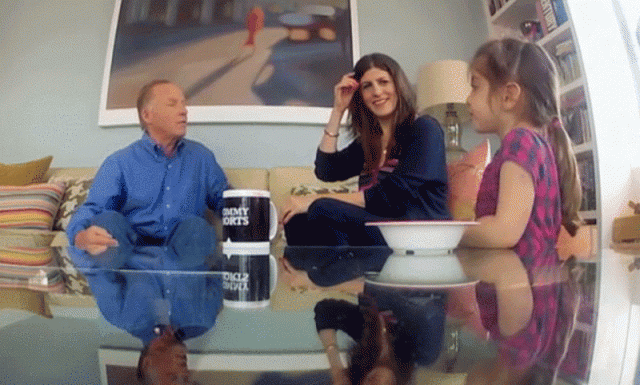 I was a pacifier kid. So is Mazzy. The day I try to get rid of that thing will be the day she hates me forever. Probably also the same reason that my mom let me hang onto mine till I was five. But at least with the pacifier, you can take it away and deal with the wrath. Mothers of thumbsuckers don't have the luxury. This week's question for Dr. B is from one such mother.
I was a pacifier kid. So is Mazzy. The day I try to get rid of that thing will be the day she hates me forever. Probably also the same reason that my mom let me hang onto mine till I was five. But at least with the pacifier, you can take it away and deal with the wrath. Mothers of thumbsuckers don't have the luxury. This week's question for Dr. B is from one such mother.
Dear Dr. B,
My 5 1/2 year old daughter, Emma, is a thumb sucker. She sucks her thumb all day and night. While this was cute when she was a baby, it is no longer. I am at my wit's end trying to get her to quit, but she barely even notices her thumb in her mouth anymore.
Emma starts kindergarten in September and I don't want her experience (which she is REALLY looking forward to) soured because other kids tease her about the thumb sucking. Also, her teeth are starting to stick forward.
How do I encourage her to quit the thumb sucking?
Signed,
Leslie, aka Emma's mom
Dear Leslie,
Occasional thumb sucking is a healthy behavior in young children and a sign that they are learning to comfort themselves. Often children naturally outgrow the habit and its best to let it run its course. Usually thumb sucking stops on its own between 4 to 6 years of age as children develop other coping skills. But if the behavior is excessive and because thumb sucking (and pacifiers) can have an impact on the development of the mouth and jaw, an intervention may be beneficial.
Because your child is 5-years-old and you have already noticed changes in her teeth, I would ask her pediatrician and/or dentist if they think it is something you should be concerned about. Additionally, you could ask them to talk to your daughter about the consequences of thumb sucking from a medical perspective (e.g., germs on hands or changing her beautiful smile). But in the event that the doctors can’t talk her out of it, below are some suggestions and steps to take that are often effective:
First, is important to consider the times of day or activities that she is engaged in while sucking her thumb, how often thumb sucking occurs throughout the day, and how long it occurs per incident.
Usually thumb sucking occurs more frequently when children are anxious, bored, or passively engaged in activities such as watching television. It might be helpful to jot down some notes, especially if it happens frequently with no apparent pattern. Recognizing these patterns will help you determine the times of day when her thumb sucking is most problematic, triggers that are associated with the onset of the behavior, and short-term goals for reducing her thumb sucking.
For instance, if you find that thumb sucking is most problematic when your child is bored or passively engaged, it may be more effective to increase your child’s engagement in activities then to try to redirect or record every instance of thumb sucking behavior. Similarly, if your child is sucking her thumb when she is anxious, teaching her coping skills to manage the anxiety will be more effective then directly addressing the the behavior.
Second, discuss your concerns about thumb sucking with your daughter without being critical or punitive. You might say, “I’ve noticed that you suck on your thumb a lot. Did you realize that you do that?” See if she can tell you why she thinks she sucks on her thumb. Then explain your concerns. For example, you could say, “I’m concerned that sucking on your thumb will hurt your teeth or change your beautiful smile.” Ask her if she thinks she can stop on her own. Or tell her you would like to help her stop and ask if she knows what might help her. Sometimes children have the best ideas but we forget to ask them. If you need to brainstorm some strategies together, you can offer the following suggestions and tell her that they have helped other children.
Develop a silent signal: Some habits are difficult to break because we don’t even realize we are doing them. Silent signals help get your child’s attention and make them aware that they are exhibiting the behavior without making them feel ashamed or criticized. This strategy involves establishing a special secret signal between the two of you that will be used to remind her when she is sucking her thumb. Try to get her to come up with a signal to use or suggest ideas (e.g., tapping your hand, placing your thumb to your mouth, or a secret handshake). This is a fun way for children to become more self-aware of their habits. It is also a good strategy that can be transferred to the school setting because it is easy for teachers to implement in a discrete way as well.
Change the Habit: When you see her sucking her thumb, you can remind her to do another behavior that provides an alternative and competing response. One alternative response that has worked with many children is clenching both fists with the thumb enclosed by the fingers. Model this behavior by showing her how to clench her fists and then counting to 20. Tell her that each time she sucks her thumb, you will remind her to do this behavior. Also, help her recognize the cues for her thumb sucking (such as a specific activity or feeling) and remind her to clench her fists before the activity begins or when she feels a certain way (e.g., tired). Praise her each time she shows you she is trying to learn or use the behavior and give her extra encouragement when she exhibits the behavior on her own. Also, remember to reward other good behaviors, especially when they are incompatible with the undesirable behavior (e.g., hands in lap).
Use rewards: Tangible rewards can be used in conjunction with the previously mentioned strategies to increase their effectiveness. This would involve rewarding your child when the number of silent signals per day decreases to a pre-established goal (e.g., less than 5 per day) or when the replacement “fist clenching” behavior increases. Another intervention that involves a reward system is rewarding your child when thumb-sucking does not occur during a set interval of the day. You may choose to divide the day into 30 minute intervals or select a few segments of time during the day that include a combination of target thumb sucking times (e.g., bedtime) and times of day when she will likely be successful at not sucking her thumb (e.g., meal time). Including both good and bad times of day will keep her motivated to earn the reward and decrease her frustration which could cause her to eventually give up.
Rewards can be in the form of stickers at the end of each day or tokens that can be traded in for a grand prize. In order to maximize the effectiveness of any reward system, it is important to select realistic goals and motivating rewards. It is best to start with goals that you know your child can achieve to get buy-in. Once they realize how exciting it is to reach their goal and are confident that they will earn the reward, they will be more likely to try again the next day. Gradually increase the goal by small increments each week to make it slightly more difficult to obtain the reward. If you find this strategy is ineffective, it often means you have selected an unrealistic goal or the wrong reward and a slight adjustment to the plan will put you back on track.
Again, it is best to talk to your pediatrician and dentist to determine whether your concerns are warranted and if other interventions are necessary. Sometimes doctors recommend using special interventions or devices such as a thumb guard, bitter substances to apply on the thumb, or a glove during the night to reduce thumb sucking when it is aggressive or rigorous. Also, if you think anxiety may be a contributing factor, consider consulting with a psychologist who may be able to treat the cause of the anxiety and teach your child alternative ways to cope.
It is important to remember that habits take time to develop and will also take time to break. Eliminating behaviors are tricky and it is best to be patient, consistent, and use a “slow and steady” approach. Similarly, when you take away one behavior, another behavior often forms in its place since the initial behavior likely served an important function. As a general rule, teaching a new appropriate behavior that serves the same function as the existing behavior will always be more effective than simply eliminating the undesirable behavior altogether.
Hope this helps,
— Dr. B
Dr. B has a PHD in school psychology specializing in early childhood development. If you would like to ask her a question, please email me at myshort@mommyshorts.com.

























my niece was a thumb sucker and my sister struggled to get her to stop. the only way she found is to reward her with something she really wanted….in my nieces case it was getting her ears pierced. so they made a deal, if she stopped sucking her thumb for 6 months she could get her ears pierced (at age 7) and it worked!
Wow! This is such an amazing article. These are all excellent suggestions. I’m Lucky, neither of my girls were thumb suckers.
I was, though. Big Time.
I sucked my thumb until I was 8 years old. My parents tried EVERYTHING.
In the end I went to a new school and on my first day of third grade someone made fun of me. That’s all it took for me to stop. I did need braces eventually, but so did almost all the other kids in my class, so it was no big deal.
Definitely not the end of the world.
I think if my mother were given her way, she’d still be sucking her thumb.
Yes, I meant that just the way I wrote it. Surprising, no?
That would totally have worked on me as a kid. I begged and begged. I think I was finally allowed at around 12.
Hazing and harassment work wonders. If there were sororities in kindergarten, I bet there wouldn’t be a thumb sucker in sight. Lots of drunk kids cleaning toilets though.
Interesting. Have you tried using a reward system? I find time with grandkids is always effective in changing behavior.
Hubs and I were both thumb suckers and consequently giant, buck-toothed elementary schoolers (and eventually braces wearers). Anna started sucking her thumb if not in-utero, then literally minutes after birth. Know a good orthodontist in New Hampshire?
I knew a girl in elementary school who had such a bad habit of thumb sucking that they had to implement a dental-thing on the roof of her mouth to get her to stop. It would poke her thumb when she would try to put her thumb in her mouth… Coincidentally, she is now a dental hygenist.
One of my twins (5 1/2 years old) is a thumbsucker. I was one, too…I don’t think I stopped until I was about 7? And although her teeth look fine and she mostly does it when she’s tired/sleeping, I still wish I could make her stop. I like the idea of a rewards system/stickers and will have to try that.
Now can you help me with my other twin who’s still wetting her pull-up at night half the time? She’s proven she CAN stay dry at night, but…argh!
Im 22 and I still suck mine. (Thankfully my teeth never suffered.)
I dont remember my parents doing anything to get me to stop but this – “One alternative response that has worked with many children is clenching both fists with the thumb enclosed by the fingers” – is a really good idea.
Even if she is teased, its not going to ruin her life. Shell be okay 🙂